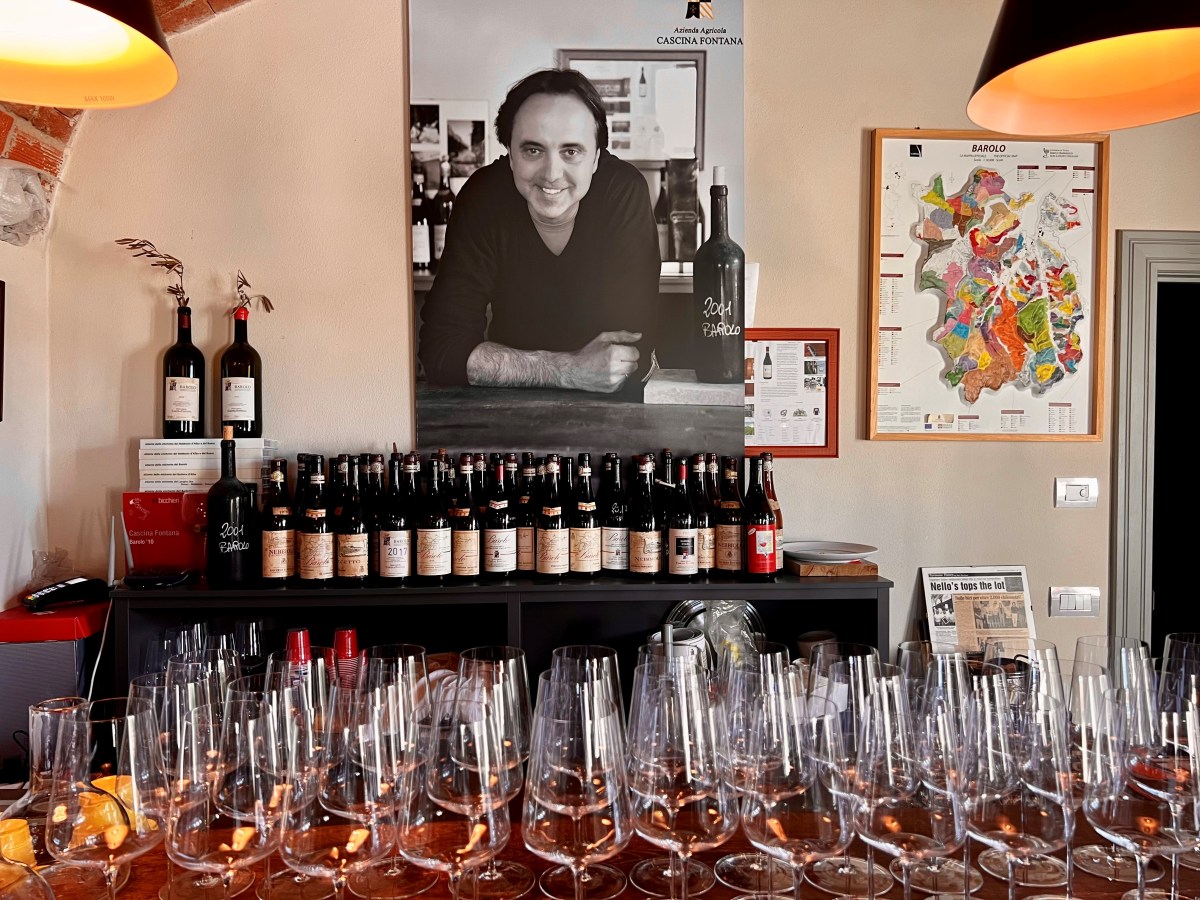
An unforgettable vertical tasting of Barolo, the legendary Piedmonts’ wine that rose from humble beginnings through passion, perseverance, and craftsmanship. This exclusive journey unveils eleven prestigious labels, each telling a story of tradition, dedication, and terroir.
As dawn breaks over the rolling vineyards of Langhe, golden light spills across the rows of nebbiolo vines, still glistening with morning dew. A soft breeze carries the fragrance of spring, mingling with the whispers of history rooted deep in this land. The hills blush pink under the rising sun, revealing secrets nurtured for generations.
At Cascina Fontana in Perno, time seems to stand still. Here, among the silent vines stretching endlessly to the horizon, the modern world fades away. In this serene setting, we prepare for an extraordinary journey through time, narrated in eleven glasses of one of the world’s most revered wines: Barolo.

The Hard Life of Langa Winemakers: Barolo’s Journey from Struggle to Prestige
In 1964, the hills of Langhe held an unspoken abundance, a treasure hidden among the vine rows. The land was already rich—though few realized it. The first sip of a decades-old Barolo reveals this truth: a wine still intact, vibrant, and sumptuous, bursting with color, aroma, and depth.
The region’s wealth lay not in gold, but in its noble Nebbiolo grape, its terroir of immense potential, and the winemaking tradition that would one day captivate the world. Yet, back then, poverty and hardship shaped Barolo’s history.
Today, vineyard land here commands exorbitant sums, but in those early years, winemakers had to struggle. Mario Fontana, with his vivid storytelling, transports us back to a time when peasant toil, harsh winters, and uncertain harvests defined life. Barolo was not made every year—in frigid seasons, the grapes never fully ripened.

Farmers sold their harvest to merchants who dictated the price, often paying only months later—if all went well. Between endless days in the fields and nights spent drinking and playing cards, these winemakers persevered, unknowingly shaping the future of one of the world’s most revered wines.
The Barolo Boys’ Revolution: How Young Winemakers Transformed Langhe
By the 1970s, the Langhe region felt stagnant—its vineyards aging, its traditions fading. The land was no longer profitable, and many young people abandoned the countryside for factory jobs. But a few refused to accept decline. They dreamed of a revolution, the kind only youth can envision—one driven by curiosity, ambition, and the relentless pursuit of excellence.
At the forefront was Elio Altare, just 25 years old at the time, who led a group of small producers on a transformative journey to Burgundy—a region that had perfected quality winemaking for centuries.

Dubbed the Barolo Boys, these pioneers traveled the world, studied renowned wines, and sought to elevate Barolo to international prestige. They didn’t invent new techniques, but they embraced a simple, powerful truth learned from the French: great wine starts with great grapes.
They introduced cluster thinning to improve grape quality and began aging Barolo in barriques—small French oak barrels that enhanced structure and complexity. For this, they were fiercely criticized. Elio Altare’s own father, unable to comprehend the change, disinherited him, passing away still convinced his son had lost his mind.
Yet, history proved them right. The Barolo Boys’ revolution reshaped Langhe, turning Barolo into one of the world’s most sought-after wines—a triumph born from risk, resilience, and a relentless belief in a better future.
Barolo: Between Tradition and Modernity
The Barolo Boys were not just a passing trend—they were a necessary revolution. They challenged the past, bringing Barolo to international acclaim while also pushing traditionalists to refine their wines, making them cleaner, more balanced, and more elegant.
Uniting two opposing philosophies was no easy task, but in the end, a shared commitment to quality and finesse prevailed. As Giacomo Conterno said over 80 years ago, “Barolo will be great when everyone makes it well.” Today, that vision has become reality, regardless of individual winemaking styles.
From the 1960s to Today: Emotion, History, and Celebration
The event was far more than a simple tasting, it was a journey through time, filled with emotion, gratitude, and deep appreciation for Barolo’s evolution—where each glass revealed the transformation of Barolo over the decades.
The setting at Mario Fontana’s Cantina was intimate yet grand, surrounded by centuries-old barrels and the soft glow of the winter’s light, evoking the timeless beauty of Langhe’s winemaking tradition. Conversations buzzed with excitement, as passionate sommeliers, collectors, and Barolo lovers shared stories, memories, and reflections on each vintage.
At the heart of the event were Francesco Bonomi and Francesco Mastrosimone, two young sommeliers with a deep love for vintage wines. Through their project, Tesori Liquidi, they carefully select bottles that still hold life within them, crafting experiences that blend history, excellence, and emotion.

An Unforgettable Lineup of Legendary Barolos
A journey through time, tradition, and culture, where every sip transported us to a different era. Some wines defy description—no words could truly capture the essence of these glasses of history:
- Fontana – Barolo Riserva 1964
- Bartolo Mascarello – Barolo 1964
- Fontana – Barolo 1971
- Aldo Conterno – Barolo Bussia 1981
- Cavallotto – Vigna San Giuseppe Barolo Riserva 1979
- Damilano – Barolo 1997
- Cascina Fontana – Barolo 2001
- Chiara Boschis – Barolo Cannubi 2001
- Cascina Fontana – Barolo 2019
- Damilano – Barolo Cannubi 2019
- Luigi Pira – Barolo 2019




![Flavor of the Land With Tequila Ocho [Infographic]](https://som2nynetwork.com/wp-content/plugins/phastpress/phast.php/c2VydmljZT1pbWFnZXMmc3JjPWh0dHBzJTNBJTJGJTJGc29tMm55bmV0d29yay5jb20lMkZ3cC1jb250ZW50JTJGdXBsb2FkcyUyRjIwMjUlMkYwNyUyRnRlcXVpbGEtb2Noby1pbmZvZ3JhcGhpYy1zb2NpYWwtMzM2eDIyMC5qcGcmY2FjaGVNYXJrZXI9MTc1Mzk3MjMwMi05ODY4JnRva2VuPTNiMDgwNGQyZGM2YjI5YzI.q.jpg)

